介绍
In small theaters, the audience is closer to the 阶段 and their emotions are more easily affected.
How to create an immersive drama experience in a limited space? LED background screens may be the key to opening the door to “immersion”.
目录
1. Why do "small theaters" need more immersion?
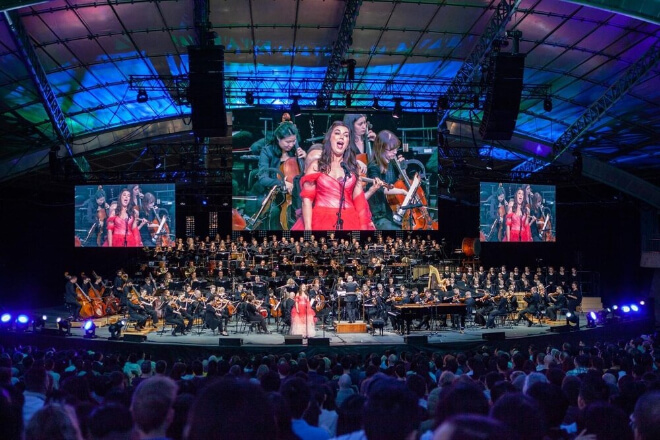
There are not many seats in small theaters, and the stage is very close to the audience. Sometimes the actors can touch the audience in the first row with just one hand.
This close distance allows the audience to clearly see every expression and movement of the actors, and even feel their emotional changes.
In this way, the audience is more likely to be brought into the plot, and their emotions are more easily driven.
Therefore, small theaters need to create an immersive atmosphere through lighting, sound effects, scenery, etc., so that the audience feels that they are not watching a play, but “in the play.”
Unlike large theaters with complex stage machinery, lifting platforms, and rotating stages, the equipment of small theaters is usually simpler, and many cool scene transitions cannot be realized at all.
At this time, it is necessary to rely on visual means such as lighting, projection, and multimedia to “fill in the gaps”.
For example, projection can be used to create different scene atmospheres, or lighting changes can be used to show the transformation of time and space.
In this way, even if the hardware conditions are limited, the audience can feel rich visual effects and will not feel monotonous or out of place.
Many of the audiences who come to watch small theater performances are drama lovers, with a particularly “poisonous” eye, and are particularly sensitive to details.
For example, if the props are not realistic enough and the costumes do not match the background of the times, the audience can see it at a glance.
In addition, the distance is close, and any small flaws will be magnified.
Therefore, small theaters must be particularly careful in handling details, and even a teacup or a piece of paper cannot be sloppy.
At the same time, the atmosphere is also very important. For example, suspense dramas need to make people nervous, and love dramas need to make people excited.
These need to be created through lighting, sound effects, and even smells, so that the audience can really “immerse” in.
Small theaters do not have the star effect or a large production like large theaters. If they want to attract audiences, they have to rely on unique experiences.
Immersive performances can give people this feeling – the audience is no longer passively watching the play, but participating in the plot and even influencing the development of the plot.
This experience is difficult to provide in large theaters, and it is also a unique advantage of small theaters.
In addition, small theaters often perform some experimental and pioneering plays. The immersive approach can help the audience better understand these works.
Lower the threshold for viewing performances, and make more people willing to enter small theaters.
2. The difference between LED background screens and traditional scenery
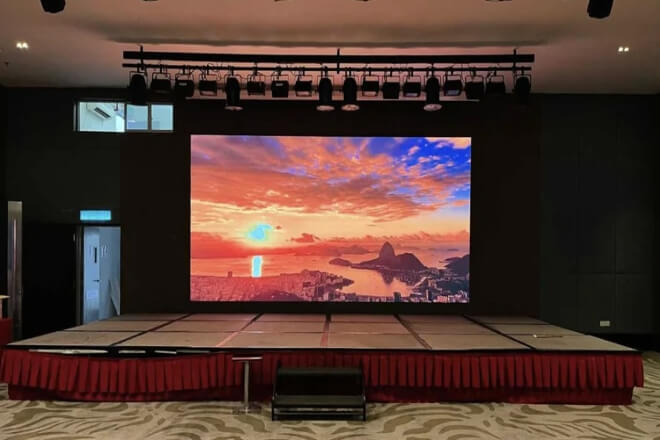
In theater performances, immersive spaces, concerts and other scenes, the difference between LED background screens and traditional scenery is no longer as simple as it seems on the surface.
They have formed a contrast of “two eras” in terms of expression, switching efficiency, cost structure and even creative freedom.
1). Static vs. Dynamic:
Traditional scenery is mostly static design, such as printing background boards and building real-scene walls.
Although the props are exquisite, they are always a “fixed visual existence. Audiences are prone to visual fatigue after watching for a long time.
The LED background screen is born with a “dynamic gene”. It can play high-definition video, three-dimensional animation, and even real-time synthesized virtual scenes.
As the plot progresses, the background can be switched freely, from forest to city, from day to night.
With almost zero delay, making the picture “active”, greatly enhancing the audience’s immersion and sense of substitution.
2). Slow operation vs. Second switching:
When switching scenes, traditional scenery often requires a lot of manual work to move props and manually replace background boards.
Not only is the process cumbersome, but it is also easy to make mistakes due to time constraints, affecting the rhythm of the performance.
The switching of the LED background screen only requires a light click through the control system.
And the screen update is completed within a few seconds. It not only switches quickly, but also achieves seamless connection.
Let the plot flow naturally without interruption, and the audience will not jump out of the play because of the “stuttering feeling”.
It is especially suitable for modern performances that require fast transitions and multiple switches.
3). Repeated consumption vs. sustainable use:
The cost of traditional scenery is not only in “production”, but the greater pressure comes from the disassembly, transportation, storage, and manpower investment in repeated use.
Especially when the troupe is on tour, the scenery must be reset and collected every time it arrives at a place, which adds a lot of hidden costs.
In contrast, after the LED background screen is installed once, it only needs to change the playback content. Although content production still requires investment.
But the physical operation is greatly simplified, saving a lot of manpower, materials and transportation costs. In the long run, it is a more sustainable and easier-to-replicate performance plan.
4). Fixed composition vs. unlimited creativity:
The visual performance of traditional scenery mostly depends on the early construction design.
Once it is finalized, it is basically difficult to adjust on-site. Creators are often limited by the physical properties of materials, space and lighting.
The LED background screen is like an infinitely expandable “creative canvas”. You can add motion effects, set weather changes, and even interact in real time with the actors’ behavior.
It is not only a background, but also a part of the plot. It can be flexibly adjusted according to the needs of the stage to truly unleash creativity.
In short, the LED background screen is not a simple “background upgrade” but an innovation in theatrical language, from the vitality of the picture to the control of rhythm.
To the controllability of cost and the freedom of creation, it far exceeds the capabilities of traditional scenery.
Especially in the current performance scene that emphasizes “immersion” and “efficiency”, the LED background screen is undoubtedly a more advanced and flexible choice.
3. Three major immersive upgrades brought by LED screens
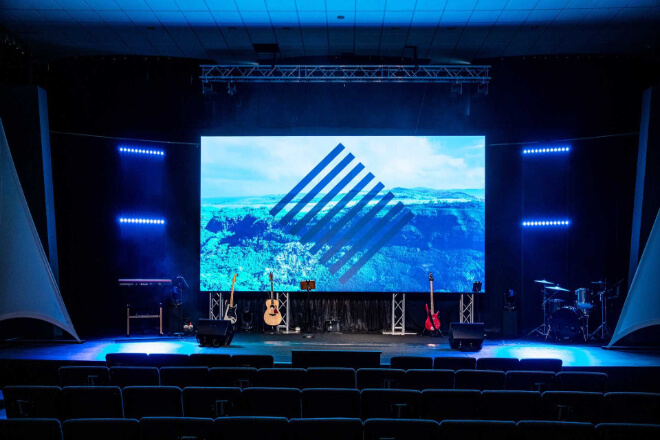
1). Visual fusion:
In a small theater, the LED screen is like a magical canvas that can perfectly blend the actors and the background.
Imagine that when the actors walk on the stage, the pictures in the background will also move.
For example, when the actors walk towards a virtual forest, the trees in the background will slowly approach, and it feels like they are really walking into the forest.
This effect is particularly suitable for the close and intimate atmosphere of a small theater.
For example, when performing an ancient Greek drama, the LED screen in the background can display the ancient Greek temple in real time.
The actors perform in front, and the audience will feel as if they are really in an ancient Greek temple.
This visual fusion not only makes the audience more enjoyable, but also makes the actors’ performances more natural, because they know that they are “one” with the background.
For some small theater performances with fantasy themes, such as dream-themed plays, the LED screen can change the picture at any time, the actors fly on the stage.
And the clouds and stars in the background also move with them. The audience is really entering the dream world. This immersive feeling is great!
2). Emotional rendering:
The charm of a small theater is that it can quickly mobilize the emotions of the audience, and the LED screen is simply an “emotional magician” in this regard.
It can change color and brightness at any time according to the needs of the plot to create a completely different atmosphere.
For example, in a sad scene, the LED screen can be adjusted to warm yellow, and the brightness can be slightly dimmed.
So that the audience feels that the entire stage is shrouded in a gentle and sad mood.
While in a tense and exciting scene, the screen suddenly turns cold blue, and the brightness suddenly increases, and the audience’s heart will also be pulled.
In addition, the LED screen can also cooperate with the stage lighting. When the lights go down, the screen also goes down, and when the lights go up, the screen also goes up.
The whole stage is like a living whole. In the performance of the small theater, this kind of emotional rendering is particularly important.
For example, when performing a love scene, when the male and female protagonists look at each other, the background screen turns soft pink.
And the audience can immediately feel the romantic atmosphere; if it is a suspenseful scene.
The background screen suddenly turns black and flashes a little red light, and the audience will immediately become nervous.
This real-time emotional rendering allows the audience to immerse themselves in the plot more deeply, crying, laughing, and even feeling nervous with the actors.
3). Space expansion:
The space of the small theater is actually quite limited, but with the LED screen, the stage seems to be enlarged by magic.
By installing LED screens on the background, sides, and even the ground of the stage, and then splicing their images together, the audience’s field of vision is expanded at once.
For example, in a play about space exploration, the stage background and the LED screens on both sides can be spliced into a huge cosmic starry sky.
The audience sitting in audience feels like sitting in a spaceship, watching the spaceship shuttle between the stars.
Moreover, if the audience wears VR glasses, this feeling of “infinite stage” is even stronger. They can see the virtual scene in 360 degrees, as if they are really in it.
In the interactive drama of the small theater, this space expansion is also very interesting.
For example, in a detective puzzle game, the background screen can display a virtual crime scene. The audience can not only watch it, but also explore the clues of the scene through interaction.
As the plot develops, the background image will change, such as new clues or hidden rooms appearing.
The audience will be completely immersed in this virtual space as if they are really solving a puzzle.
This space expansion effect makes the stage of the small theater no longer a simple plane, but a virtual world that can be infinitely extended, and the audience’s experience is directly maximized!
4. What kind of LED screen is more suitable for a small theater?
Although the space of a small theater is not large, the requirements for stage performance are not low.
On the contrary, because “the audience is too close to the stage, the scene changes frequently, and the atmosphere requirements are extremely strong”, higher requirements are put forward for the LED display.
So, what kind of LED screen is really suitable for a small theater? We analyze from three key angles:
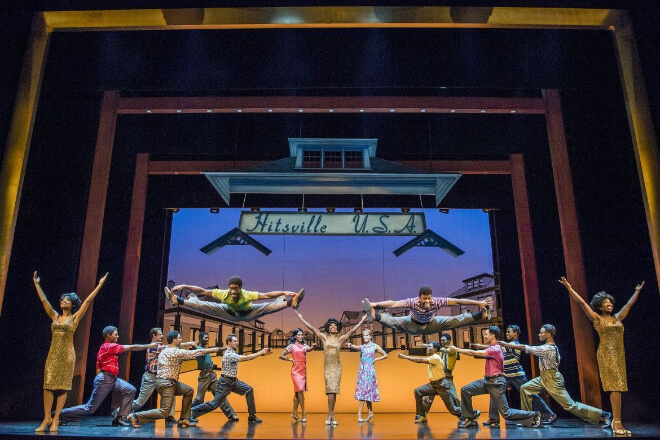
Venue characteristics 1: Close-up viewing, the picture must be delicate enough
- Recommended: 小号mall-pitch LED display
The space of a small theater is limited, and the audience seats are usually only a few meters or even closer to the stage.
Once the pixel particles of the LED screen are too obvious, it will affect the viewing experience and even make people feel out of the game.
Therefore, the first choice for a small theater is a small-pitch LED display, usually with a dot pitch below P1.5.
The small-pitch screen has a higher pixel density and can achieve high-definition picture quality. Even if the audience watches from a close distance, there will be no “mosaic” or blur.
For example, in a close-up or emotional scene, the subtle facial expressions of the actors and the texture of a leaf in the background can be accurately presented.
Making it easier for the audience to get emotional, and the actors can also fully exert their performance tension on a more “real” stage.

Venue feature 2: The stage atmosphere pays attention to the changes of light and shadow, and the picture cannot be “flat.”
- 推荐: LED screen that supports high grayscale and HDR technology
Small theater performances rely heavily on lighting and pictures to create an atmosphere.
Whether it is a warm scene, a dream transition, or a mysterious space, it has extremely high requirements for the color expression of the screen.
At this time, LED screens with high grayscale and HDR (high dynamic range) technology can really be competent for stage performance tasks.
High grayscale technology allows the LED screen to maintain color levels at low brightness, without graying or color cast.
HDR technology enhances the contrast of details between bright and dark parts, and the picture is more three-dimensional and realistic.
For example, when performing a scene in the early morning of a forest, the sun shines through the branches and leaves on the ground.
The LED screen can clearly show the effect of the interweaving of sunlight and shadows, making the audience seem to be in nature, and the visual atmosphere instantly “stands up”.
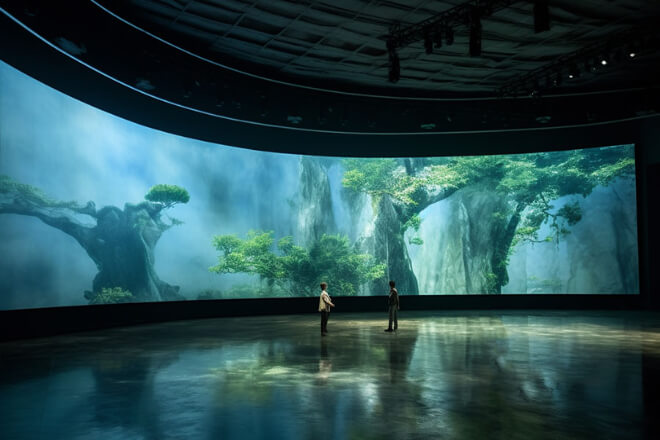
Venue feature 3: The stage structure is irregular, and the screen must be flexible to adapt
- 推荐: Curved LED screen, 柔性LED显示屏 or special-shaped customized LED screen
The stage design of small theaters is often eclectic, sometimes with a semicircular stage background, sometimes with a staggered step structure, and even a maze-like immersive layout.
This complex stage is difficult to cover completely with traditional flat LED screens. At this time, curved screens and special-shaped screens play a huge role.
The curved screen can perfectly fit the curved background, which is not only more natural visually, but also enhances the sense of surround of the space.
While the special-shaped screen can be customized according to the convex, corner, groove and other structures of the stage, so that the screen can be “embedded” into the stage like a puzzle.
Not only can it achieve a more complete picture coverage, but it can also create various “fantasy” visual effects according to the needs of the plot.
For example, in an immersive theater performance, the special-shaped LED screen laid on the maze wall can change the scene in real time according to the movement of the audience, bringing a highly interactive visual experience.
5. 结论
When the stage is no longer limited to physical space, when the background is no longer just a static picture, the charm of the small theater is also redefined.
Do you also expect that the next time you walk into the theater, you will be brought into a whole new world by a screen?
最后,如果你想了解更多关于LED显示屏的信息, 请与我们联系。
